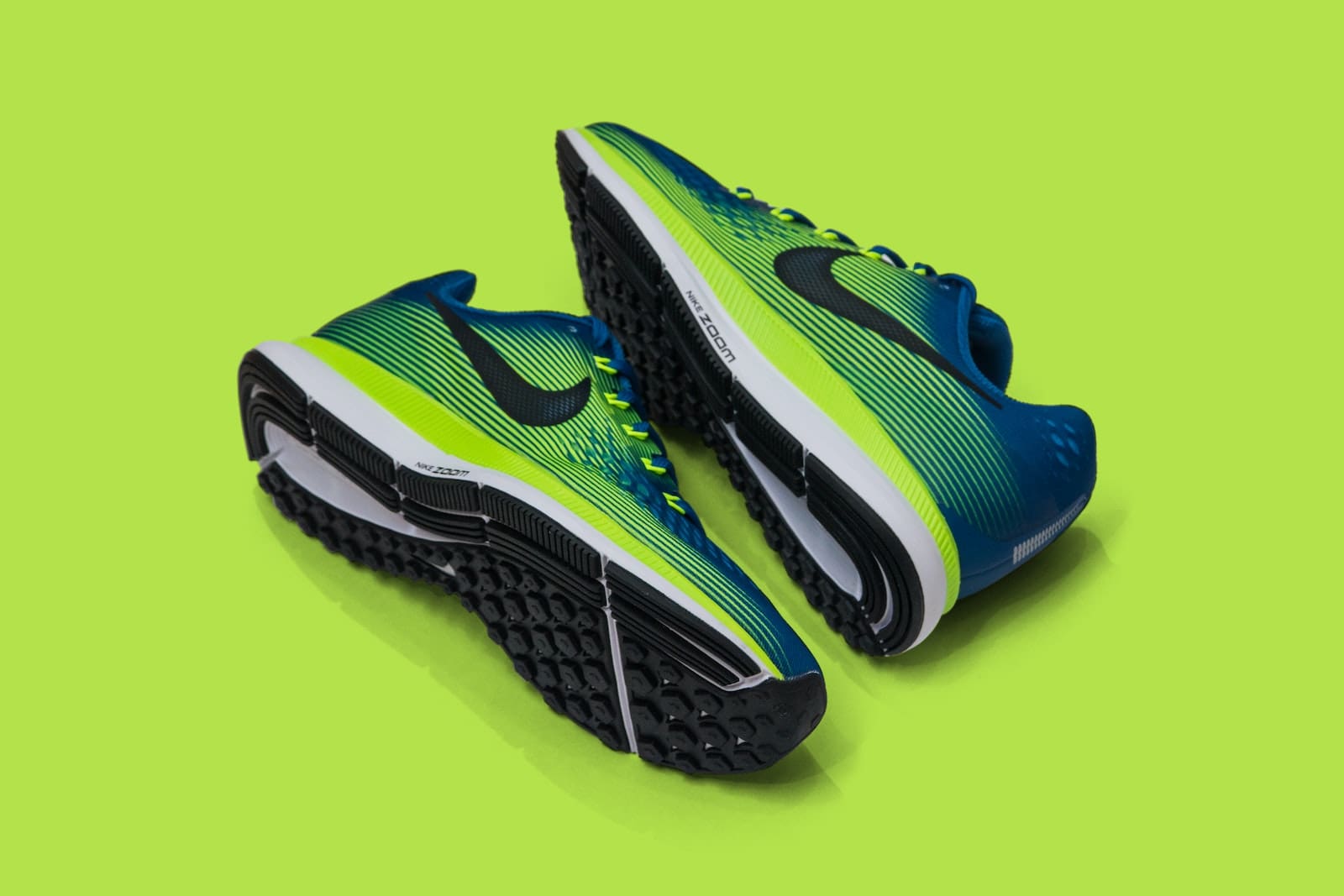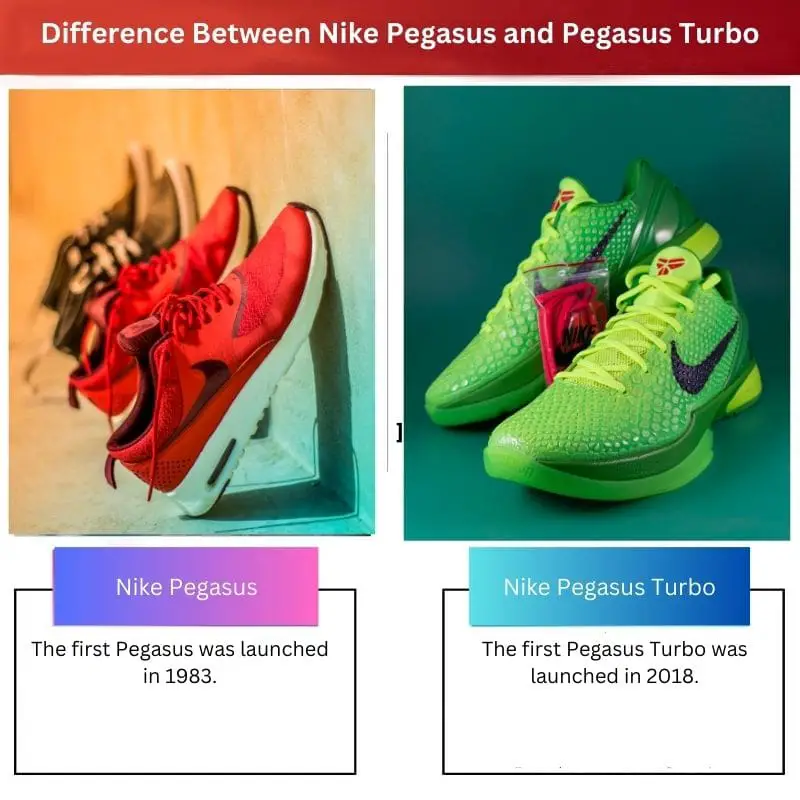Nike has been one of the leading companies when it comes to sports equipment. Since the launch of their first iconic pegasus shoes in 1983, they have been consistent in delivering top-quality shoes to players all around the world.
While the choices of sports shoes offered by Nike are more than enough, Nike’s Pegasus and Pegasus Turbo are two specific models which are similar but offer considerable differences too.
Key Takeaways
- The Nike Pegasus is a more affordable and versatile running shoe, while the Pegasus Turbo is a higher-end shoe designed for speed and performance.
- The Pegasus Turbo has a lighter weight and more responsive foam cushioning than the Pegasus.
- The Pegasus Turbo is also more expensive than the Pegasus due to its advanced features and materials.
Nike Pegasus vs Nike Pegasus Turbo
Nike Pegasus are shoes designed by Nike, a famous shoe company. These shoes are designed for normal training and running. Nike Pegasus are comfortable for the long run. Pegasus turbo shoes are designed for professional runners and trainers. Pegasus turbo shoes are light in weight and are more flexible than Nike Pegasus.

Nike Pegasus is Nike’s oldest and most successful lineup of shoes since 1983. It was designed for runners as it provided comfort, good flexibility, and stability at the same time.
There have been a total of 30 shoes in Nike’s Pegasus lineup.
Nike Pegasus Turbo’s first pair of shoes were introduced in 2018, which was a serious upgrade over the already popular pegasus lineup.
Pegasus Turbo comes with Nike’s best foam technology, is lighter weight, and has extremely high flexibility specifically designed for hard trainers and professional runners.
Comparison Table
| Parameters of Comparison | Nike Pegasus | Nike Pegasus Turbo |
|---|---|---|
| Launched in | The first Pegasus was launched in 1983. | The first Pegasus Turbo was launched in 2018. |
| Weight | A single shoe weighs less than 300 grams. | A single shoe weighs about 200 grams. |
| Shoe Type | Cushioning. | Lightweight. |
| Flexibility | Offers moderate flexibility. | Highly flexible. |
| Foam | Uses Nike’s React foam. | Uses Nike’s ZoomX foam. |
What is Nike Pegasus?
Nike introduced the Pegasus in 1983 as shoes for runners. At the time of its release, pegasus gained popularity in a very short time.
Providing excellent sole quality, good flexibility, and durability with a comfortable structure, pegasus has always been best-in-class.
In the last 38 years, pegasus has undergone major technological shifts and improvements with each new version of the lineup. There have been over 30 versions of Pegasus since its release.
It is by far the best-selling running shoe of Nike.
Pegasus shoes are known for their clean-cut and simple look. Pegasus shoes were built for long-distance running. They also have good cushioning and a very small upper tongue with ten-millimeter heel setoff.
The latest offering by Nike’s Pegasus, Pegasus 38, has built-in aesthetical designs. It also comes in a variety of colours such as black, platinum, navy blue, etc. Nike Pegasus is also suitable for non-athletic wear.
In 1987, Pegasus launched their versions in smaller form factors specific for children. Furthermore, in 2004 for the first time in Pegasus history, the women’s version was also adapted, keeping in mind the anatomy of the female foot.
The women’s saddle was made more comfortable, and the medical support was further increased. For children and women, Pegasus has been a part of the pegasus lineup ever since.

What is Nike Pegasus Turbo?
Nike introduced Pegasus Turbo in 2018 following the success of the original pegasus for over 3 decades. Pegasus Turbo offers Nike’s best-ever components in the model, including ZoomX combined with React Foam cushioning.
Till now, there have been only two versions of the lineup, including the original Pegasus Turbo and the latest Pegasus Turbo 2.
Pegasus Turbo is known for its lighter and sleeker form factor than the regular pegasus. Pegasus Turbo is noticeably lighter than the other shoes in its segment, and it will make the wearer feel more responsive and faster while running.
Even though it’s a running shoe, Nike has not compromised on the style either.
While the overall form factor and balance of the shoe are excellent, some consumers did complain about slight instability, especially on wet concrete.
Since the lightweight and flexibility are the highlighting points, stability does get affected a little, but it’s not a deal-breaker for most people.
With the latest Pegasus Turbo 2, The upper material and construction of the shoe are completely new, which results in a wider forefoot fit, higher toe-box, and better ventilation.
It is available in many colours, including White, Blue Void, Football Grey, Photo Blue, etc.

Main Differences Between Nike Pegasus and Pegasus Turbo
- While the pegasus returns about 60% of the energy, the pegasus turbo promises about 85% energy return, resulting in better performance.
- Even though pegasus shoes offer good flexibility, they are not subpar with pegasus turbo, which offers best-in-class flexibility.
- Pegasus shoes are more stable and rigid as compared to pegasus turbo shoes.
- Pegasus’ sole is not as light as the pegasus turbo. Hence, the pegasus turbo is lighter in weight.
- Pegasus shoes are available in many models and colours, whereas pegasus turbo being a new lineup, includes only two models.

The article presents a thorough examination of these two Nike shoe models. The differences outlined, especially in terms of weight and flexibility, are crucial for potential buyers.
Indeed, the article serves as a valuable resource for anyone considering purchasing running shoes. It’s informative and illuminating.
I couldn’t agree more. It’s refreshing to come across an article that delves into such nuanced details about sports equipment.
I appreciate the meticulous comparison of Nike Pegasus and Pegasus Turbo. It’s evident that each model serves a different purpose, and the article makes that clear.
Yes, the article effectively captures the essence of the two shoe models. It’s essential to understand the distinctions, especially when it comes to performance-oriented footwear.
Interesting insights into the technological advancements of the Pegasus Turbo. The information on the energy return and flexibility is particularly enlightening.
Great article! It’s interesting to see how Nike has evolved its shoe design over the years. I’ve been a Pegasus fan for a long time, and I appreciate the insights into the differences between Pegasus and Pegasus Turbo.
Yes, I agree. The article has contributed to my understanding and appreciation of Nike’s innovations. It’s always inspiring to see how brands keep perfecting their products.
The article does a great job of highlighting the main differences between the Nike Pegasus and Pegasus Turbo. It provides a comprehensive overview that can help with making an informed decision about which pair to choose.
Agreed. I appreciate the depth of the analysis, and it’s clear that a lot of detail and research went into this.
Absolutely, I found the comparison table particularly helpful. It’s essential to consider the various parameters when deciding on the right sports shoe.
The article provides an insightful look into the history and specifications of the long-standing Pegasus and the innovative Pegasus Turbo. It’s a commendable piece of work.
I have to say, I’m not entirely convinced by the marketing of the Pegasus Turbo. While it claims to offer better performance and flexibility, I think the article effectively outlines the potential drawbacks, such as reduced stability.
I see your point, and it’s crucial to weigh the pros and cons when considering a new sports shoe. It’s always refreshing to see a balanced appraisal of new products.
The historical background provided by the article is valuable, giving readers an understanding of the legacy and evolution of the Pegasus lineup.